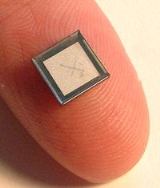
Micropump
Encyclopedia
Although any kind of small pump is often referred to as micropump, a more accurate and up-to-date definition restricts this term to pumps with functional dimensions in the micrometre range. Such pumps are of special interest in microfluidic research, and have become available for industrial product integration in recent years. Their miniaturized overall size, potential cost and improved dosing accuracy compared to existing miniature pumps fuel the growing interest for this innovative kind of pump.

micropumps, and sparked the interest in shrinking the size of a fully functional pump to new dimensions.
Within the microfluidic world physical laws change their appearance: As an example, volumetric forces, such as weight or inertia, often become negligible, whereas surface forces can dominate fluidical behaviour, especially when gas inclusion in liquids is present. With only a few exceptions, micropumps rely on micro-actuation principles, which can reasonably be scaled up only to a certain size.
Micropumps can be grouped into mechanical and non-mechanical devices: Mechanical systems contain moving parts, which are usually actuation and valve membranes or flaps. The driving force can be generated by utilizing piezoelectric, electrostatic, thermo-pneumatic, pneumatic or magnetic effects. Non-mechanical pumps function with electro-hydrodynamic, electro-osmotic, electrochemical or ultrasonic
flow generation, just to name a few of the actuation mechanisms that are currently studied.
, Lab-on-a-Chip
System) requires some kind of micropump system. In addition, macro-fluidic systems which rely on miniature pumps might be reduced in size or enhanced in their functionality by integrating a micropump. Emerging technologies, such as portable fuel cell applications
will benefit when smaller yet more energy efficient pumps become available on the market. In 2003, the first commercial availability of a micropump was announced. Other companies have followed with their own pumps. All commercially available micropumps depend on piezoelectric actuation and incorporate passive check valves. Micropumps made of polymers appear to yield potentially low unit prices, while silicon micropumps prove to be the smallest pump devices in the world.
It has to be seen which of these pumps will be the first one to be successfully integrated into a commercially available product.
Types and technology
In this sense, first true micropumps were reported on in 1975. However, the micropumps developed by Jan Smits and Harald Van Lintel in the early 1980s are considered to be the first genuine MEMSMicroelectromechanical systems
Microelectromechanical systems is the technology of very small mechanical devices driven by electricity; it merges at the nano-scale into nanoelectromechanical systems and nanotechnology...
micropumps, and sparked the interest in shrinking the size of a fully functional pump to new dimensions.
Within the microfluidic world physical laws change their appearance: As an example, volumetric forces, such as weight or inertia, often become negligible, whereas surface forces can dominate fluidical behaviour, especially when gas inclusion in liquids is present. With only a few exceptions, micropumps rely on micro-actuation principles, which can reasonably be scaled up only to a certain size.
Micropumps can be grouped into mechanical and non-mechanical devices: Mechanical systems contain moving parts, which are usually actuation and valve membranes or flaps. The driving force can be generated by utilizing piezoelectric, electrostatic, thermo-pneumatic, pneumatic or magnetic effects. Non-mechanical pumps function with electro-hydrodynamic, electro-osmotic, electrochemical or ultrasonic
Ultrasound
Ultrasound is cyclic sound pressure with a frequency greater than the upper limit of human hearing. Ultrasound is thus not separated from "normal" sound based on differences in physical properties, only the fact that humans cannot hear it. Although this limit varies from person to person, it is...
flow generation, just to name a few of the actuation mechanisms that are currently studied.
Industrial integration
Any kind of active microfluidic handling or analysis system (µTasMTAS
MTAS may refer to:*Medical Training Application Service*The railway company Malmtrafikk*Ericsson's Multimedia Application Server Ericsson MTAS...
, Lab-on-a-Chip
Lab-on-a-chip
A lab-on-a-chip is a device that integrates one or several laboratory functions on a single chip of only millimeters to a few square centimeters in size. LOCs deal with the handling of extremely small fluid volumes down to less than pico liters. Lab-on-a-chip devices are a subset of MEMS devices...
System) requires some kind of micropump system. In addition, macro-fluidic systems which rely on miniature pumps might be reduced in size or enhanced in their functionality by integrating a micropump. Emerging technologies, such as portable fuel cell applications
Portable fuel cell applications
Fuel cell applications are stationary fuel cell applications and portable fuel cell plications...
will benefit when smaller yet more energy efficient pumps become available on the market. In 2003, the first commercial availability of a micropump was announced. Other companies have followed with their own pumps. All commercially available micropumps depend on piezoelectric actuation and incorporate passive check valves. Micropumps made of polymers appear to yield potentially low unit prices, while silicon micropumps prove to be the smallest pump devices in the world.
It has to be seen which of these pumps will be the first one to be successfully integrated into a commercially available product.

